As we add more methods of communication to our lives, so increases the chances for scammers to exist. Think about spam emails – how often do they end up in your Spam folder today?
Think back to a time when you received an SMS from a company that just didn’t sit right with you. The text’s tone may be too casual, or the link looks slightly off. This is because that SMS was probably a scam text message.
Scam text messages are quite a privacy intrusion and can create chaos for you. Let’s dive into what scam text messages are.
What are scam text messages?
Scam text messages, also known as SMS phishing or “smishing,” are designed to trick consumers into giving personal data to cyber criminals who pose as familiar companies, friends, or family members. These attackers usually use scam text messages to gain data like usernames and passwords to bank accounts, social security numbers, and credit card details. Other scam text messages want users to download malware or viruses by clicking on inconspicuous links, including text abbreviations.
For Americans, scam texts have increased from 16.9 per month in April 2021 to 41 in April 2022. That’s a huge number to deal with on a monthly basis. Experts say this number is set to only increase in the future. So, as an individual, what can you do? Well, you should be proactive by learning how to identify and avoid common scam text messages. This way, you’ll be protecting yourself and your personal data while still being able to use text messaging effectively.
Common Scam Text Messages and How to Identify Them
Understanding that scam text messages exist is one thing. But knowing how to identify them is absolutely essential. We’ve collated a list of common examples to help you identify phishing texts and avoid interacting with them.
1. Congrats, you’ve won!
One of the most common (and enticing) phishing texts is one which says you’ve won something. This can be anything from winning a gift card to a cruise ticket. Generally, these scam texts include the monetary value as well as a link “to claim your prize.” They also tend to have spelling errors and unrealistic links. Here’s an example:

2. Urgent! The IRS is attempting to contact you
These scam text messages are usually more frequent around the annual tax season. But the truth is that the IRS will never contact you via SMS or email. They won’t even contact you via phone. The most common method of communication is via certified letter or mail. If you see a text saying you need to click on a link to verify your IRS tax refund, it is a scam text message. Here’s an example of what this could look like:
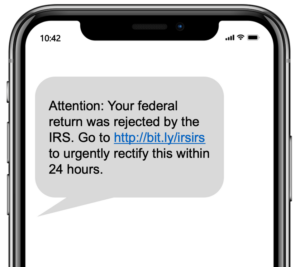
3. Incoming refund
The next scam text message is one that catches a lot of people unaware. It’s often believable because it’s all about refunds. If you think about how often the average American orders from online stores like Amazon, it’s quite frequent. So, when you receive a scam text message about an Amazon refund, it’s easy to think it’s the real deal. Below is an example of an incoming refund scam text message:
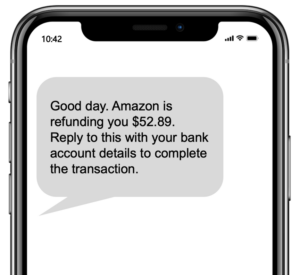
4. Verify or secure your bank account
Some scammers pose as financial institutions to try and retrieve your banking information. This includes things like your bank account number, routing number, etc. This is illegal, and no official financial institution would ask for your information via text message marketing. Below is a display of what this type of scam message could look like:
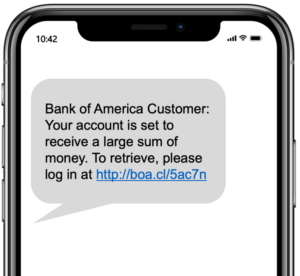
5. Delivery of package
In today’s world, people receive multiple deliveries in a week. This is why scammers pretending to be UPS or FedEx can come across as legitimate. Some couriers do send texts with tracking numbers. As you can see in the text sample below, this scammer is requesting personal data. But no official shipper will ever ask you for personal information – all their text should do is provide package status updates.
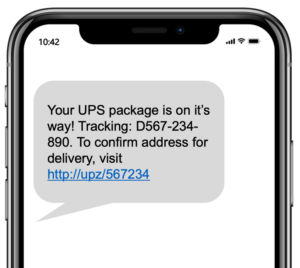
6. Apple iCloud ID verification
This is tricky because companies like Apple will contact you should your account be compromised. But they will never text you for verification without using a code in tandem with another channel – email. If your Apple iCloud ID or account was compromised, Apple will contact you directly with step-by-step instructions on changing your passwords and enabling two-step verification. If you see a text similar to the one below, it is a scam:
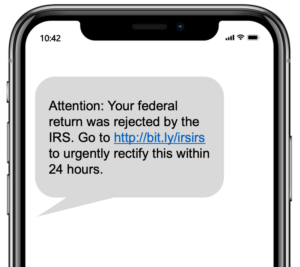
7. Offer from Bitcoin
If you come across a text message saying you’ve received money from an entity such as Bitcoin, you shouldn’t be too quick to believe it. With trending topics like Bitcoin in the news, it’s easy to believe that “new age” investments will send you money to lure you into spending more with them. But this isn’t true. Scammers can use Bitcoin scams in an attempt to gain your personal information and later use it in exchange for payment – also known as blackmail scams. Here’s an illustration of what it would look like:
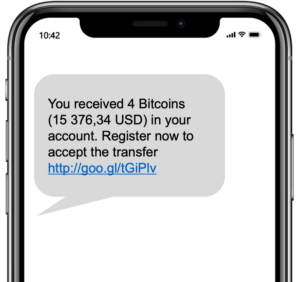
8. Help needed from a family member
This has to be one of the most difficult and disturbing scam text messages out there. This scam text explains that a family member is in peril and needs urgent attention. Usually, the SMS has a link for you to click on to wire money to get them out of the trouble they’re in. It’s an extremely difficult scam text to deal with. If anyone is in peril, it’s important to note that official medical or financial intuitions will contact you before anyone else.

9. Your account needs reactivation
These days, we have so many accounts on so many platforms and websites. And scammers know this. This is why they use reactivation scam text messages so often. Usually, the SMS will say something like your account has been compromised, and you’ll need to follow a link to reactivate it. In most cases, text abbreviations are used in the link as well. If you receive a text like this, contacting that business directly is best to ensure your account is safe.
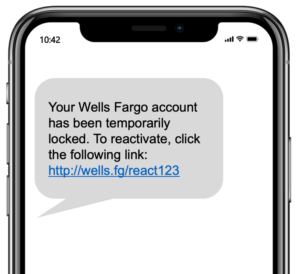
10. Thanks for your purchase
Often scammers use purchases as an excuse to get your attention. For example, they may send you an SMS that is thanking you for a recent purchase – even though you didn’t make that purchase. This scam is designed to make you click a link or call a number to enquire about the transaction. If you do receive a text about a recent purchase you didn’t make, it’s important to contact the business directly to enquire about all recent purchases.

Tips for Protecting Yourself from Scam Text Messages
To protect yourself from scam texts and SMS fraud, there are a couple of steps you can take:
Step 1: Verify the sender’s identity
The first step is probably one of the most important ones – verify the sender. For example, if you get a text from the IRS, the bank, or any other official institution or business, it’s best to call them to verify the message’s genuineness.
Step 2: Avoid clicking on suspicious links or downloading unknown files
If you receive a text from a number you don’t recognize, you should be aware – especially if that text has a link in it. In most cases, the link will have text abbreviations in it. This is to help shadow the fact that it is a scam. If you don’t see an official website URL in the link, do not click it.
Step 3: Be cautious with sharing personal or financial information
Scammers often ask for your personal or financial information. This is why you mustn’t reply to any texts from an unknown number. You should also be cautious before calling any number within the text message. Usually, this is all an attempt to gain personal or financial information from you so that money can be taken from your account or personal data can be kept for blackmail purposes.
Step 4: Install security software and keep it up to date
Security software is a great help when it comes to scam texts. Many anti-malware apps can help protect you from SMS phishing links. This software is designed to keep your identity and personal data secure. But once you have security software installed, you must keep it up to date to ensure you’re always protected from malicious texts, apps, and content.
Step 5: Report and block scam text messages
When you receive a text message that you flag as a scam text, you must take a few seconds to report the message and block the number. This may sound like too much effort when deleting the message is enough – but by blocking the number and reporting it, you’re flagging that scammer for other users. And the more we all make an effort to report scams, the higher the chance of them becoming restrained.
Step 6: Educate yourself and stay updated on new scam techniques
As we know, technology keeps changing. For example, Bitcoin has become so popular in recent years. As a result, more Bitcoin-related scam texts have come to pass. With this in mind, it’s important to be vigilant and constantly learn new scam techniques to be well-prepared when you receive a scam text message.
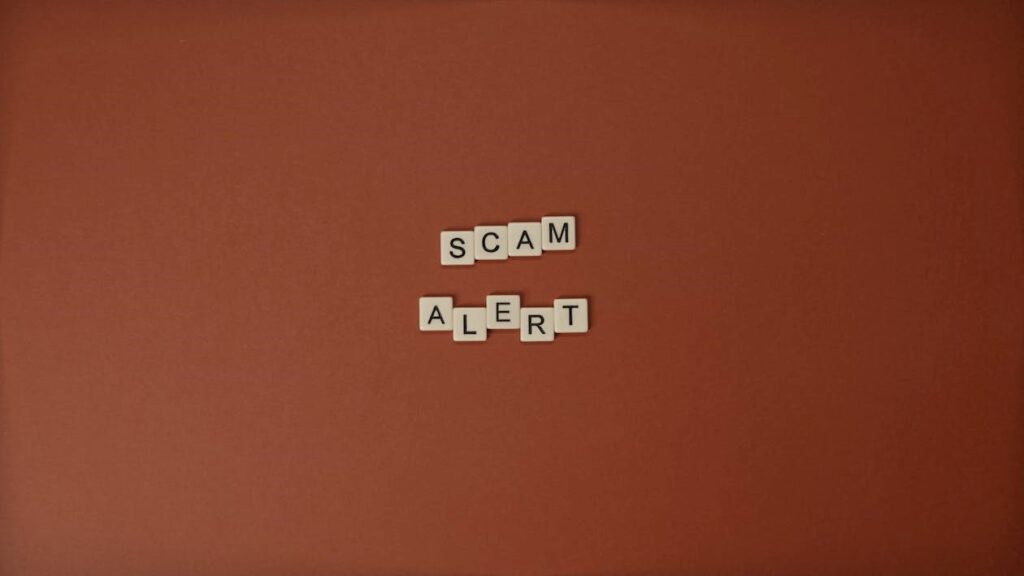
What to Do if You Fall for a Scam Text Message
If you received a text message and replied to it or clicked a link in it and later realized that it was part of a scam, don’t fear – you still have a few options and steps you can take to rectify it:
1. Act quickly to protect your personal and financial information
The first thing you should do is to act quickly. Analyze the type of scam text message it was to identify what the scammer was trying to get from you – personal data, money, or financial data are the most common things. Now you’ll know who to contact first and which areas to handle as your highest priorities.
2. Notify your bank and credit card providers
The next step is to contact your bank and any credit card providers to help you change your banking passwords and temporarily lock your bank accounts and credit cards. This will prevent the scammer from making transactions using your credit card or bank account.
3. Change passwords for affected accounts
Another must-do is to change all your passwords to any affected or related accounts. For example, if your bank account was compromised, change your online banking password. If you use the same password (which you shouldn’t for safety) for other online logins like your email – change those too. You never know how many platforms a scammer will try to access with one password.
4. Report the scam to the appropriate authorities
Once you have changed all necessary passwords and notified your banks, it’s time to report the scam to the proper authorities. There are authorities, in addition to official law enforcement agencies, who can be reached. Remember, reporting scam text messages helps create a solid record of the incident and helps recover stolen data or funds.
5. Learn from the experience and be more vigilant in the future
The last step is to learn from your experience and be more vigilant in the future. As we discussed earlier, spam texts are constantly evolving, and keeping up with the news is important to keep track of the latest spam styles. If more recipients report scam text messages, more authorities will be able to block scammers, hopefully, stop them in their tracks.
If you’re a business sending texts as part of your marketing campaign, it’s a good idea to invest in text message marketing software like Gleantap. This software is designed to help you send safe, secure, and authentic texts to your contact list. You can create SMS templates and customer segments and follow all text marketing best practices from one platform. So you can enjoy safe and protected customer communication at all times.
FAQs
1. How can I identify a scam text message?
If the text comes from an unknown number, and it has one of the following, it is probably a scam text message: urgent language, short and foreign links, a request for personal information, or payment.
2. What should I do if I receive a scam text message?
You should warn friends and family about the scam. Share the details of the scam and remind your family or friends to be vigilant of similar messages. If the scam is related to a specific business or authority, contact them to report the scam.
3. What are some common types of scam text messages?
Scams pretending to be your bank, the IRS, or a business like Amazon or Netflix. Other scam texts include someone claiming that you’ve won a prize.
4. What information should I never share in response to a text message?
Never share personal data such as bank details or credit card numbers unless you can verify that the user is who they claim to be.
Get the full story here:


